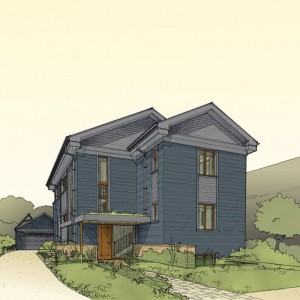The River Forest passive house discussed in this post we published early in 2013 is featured on the upcoming Green Living and Learning Tour on Sept. 28th. Read more about it in this article, and plan to stop there on the Tour! Oak Park architect Tom Bassett-Dilley has designed the first certified passive house to be built in the Chicago area. The new house, built for the Lema family, uses only a small fraction of the heating and cooling energy of a conventional house.
Based on an interview with Tom Bassett-Dilley conducted by Doug Burke
As the 28th certified passive house in the United States the River Forest home represents a small but growing movement. Bassett-Dilley, who heads the Passive House Alliance in Chicago, predicts that there will be 200 or more in the country by the end of this year. There are many more passive houses in Europe.
What is a Passive House?

The name “passive” means that these houses use the environment around them as much as possible – for instance, by having lots of south-facing windows to take in the sun's heat in the winter, but with overhangs to shade those same windows in the hot summer. Smart design reduces the amount of the work the home has to do to maintain comfort. And a very tight building envelope means it doesn't take nearly as much energy to heat or cool the house. A house built to the new Illinois code (just revised effective this month) is required to have no more than 5 air changes per hour. A passive house must have no more than 0.6. The River Forest house tests out at just 0.38 air exchanges per hour – far tighter than required by either standard.
There still has to be ventilation; a mechanical system draws out moist air from kitchen, bathrooms, and laundry, and feeds in air to the living areas. Very good efficient heat exchangers retain 85% of the heat.
This produces a very comfortable and simple house, which use about 75% less energy than built-to-code homes to heat and cool. Over a 30-year mortgage, the heating and cooling savings should at least make up for the slightly higher cost of construction -- about 10% higher, with 18-inch thick walls, thick insulation even under the building, and tight sealing everywhere. Even with today's exceptionally low natural gas costs, a passive house should still be less expensive to own and operate than a conventional one. And it is much better for the environment, using only a small amount of electricity in heat pumps for heating and cooling. There is no need for a gas-burning furnace, nor any air-conditioning system except the heat pumps.
Learn more about this house, including the non-toxic and recycled materials used in building it, how it is laid out, and how it fits into the neighborhood, at Sustainable Chicago. See also the article titled "The Heat is On - River Forest Home to be area's first certified passive house," in the January 2, 2013, edition of the Wednesday Journal, p. 35.


